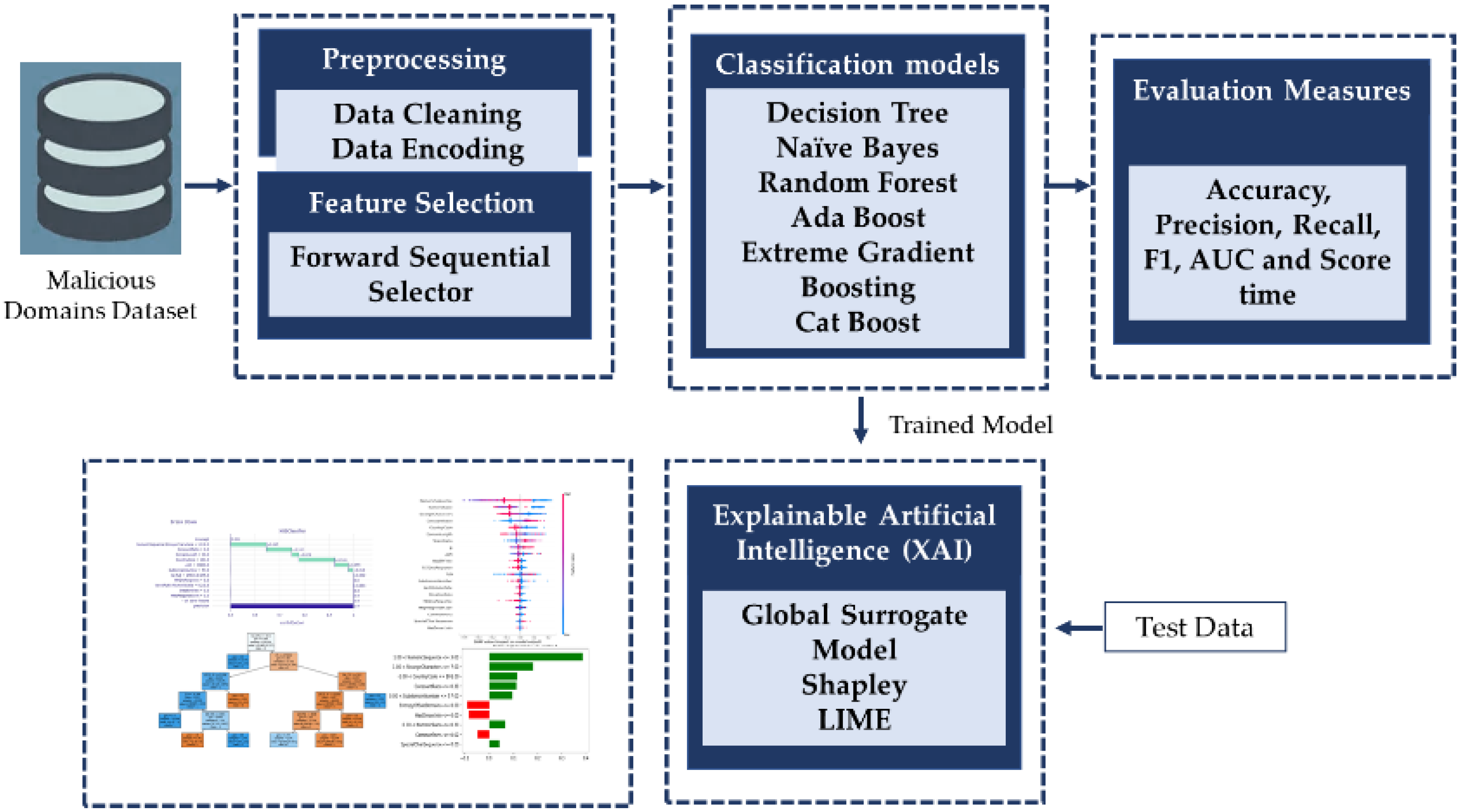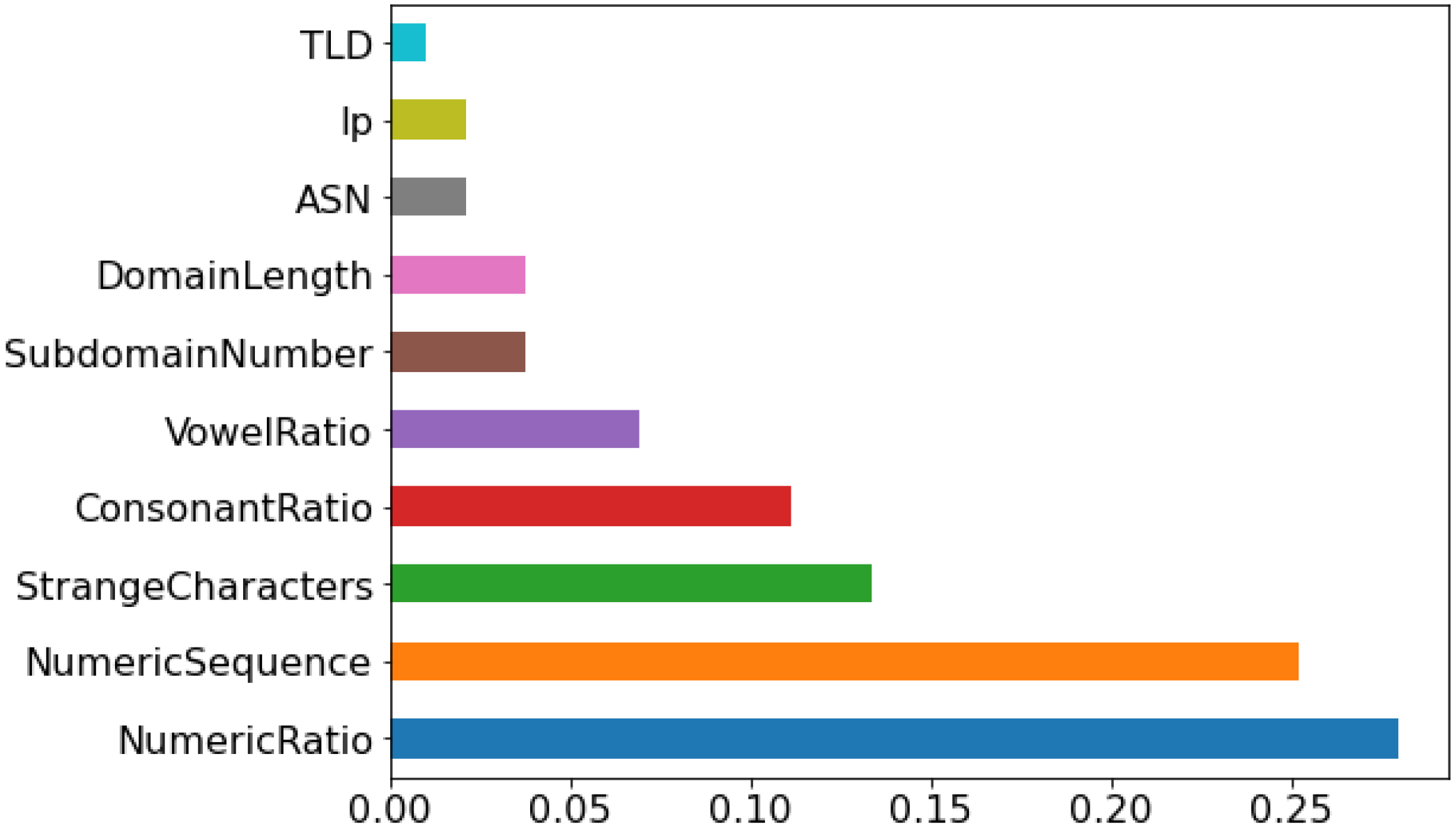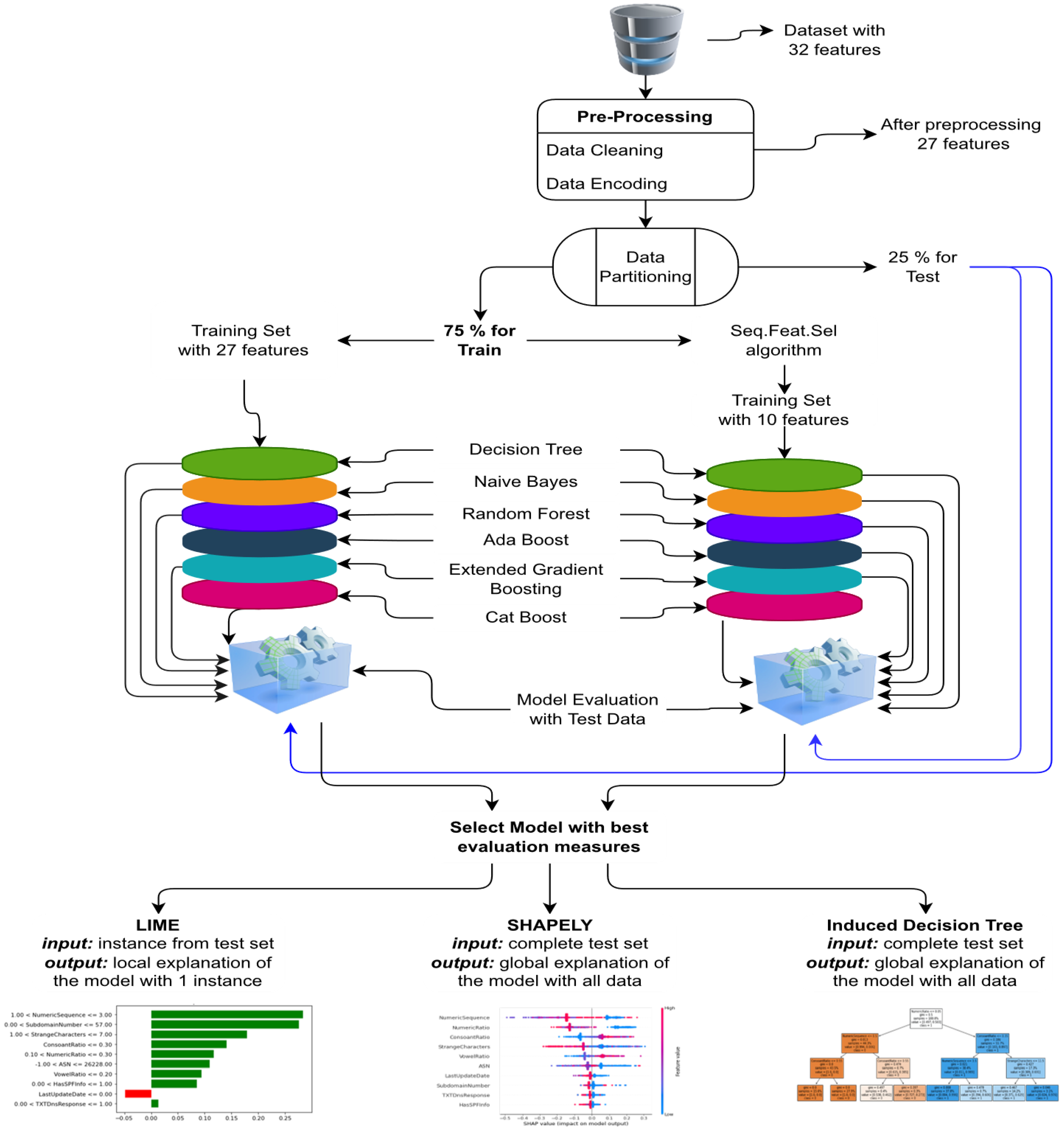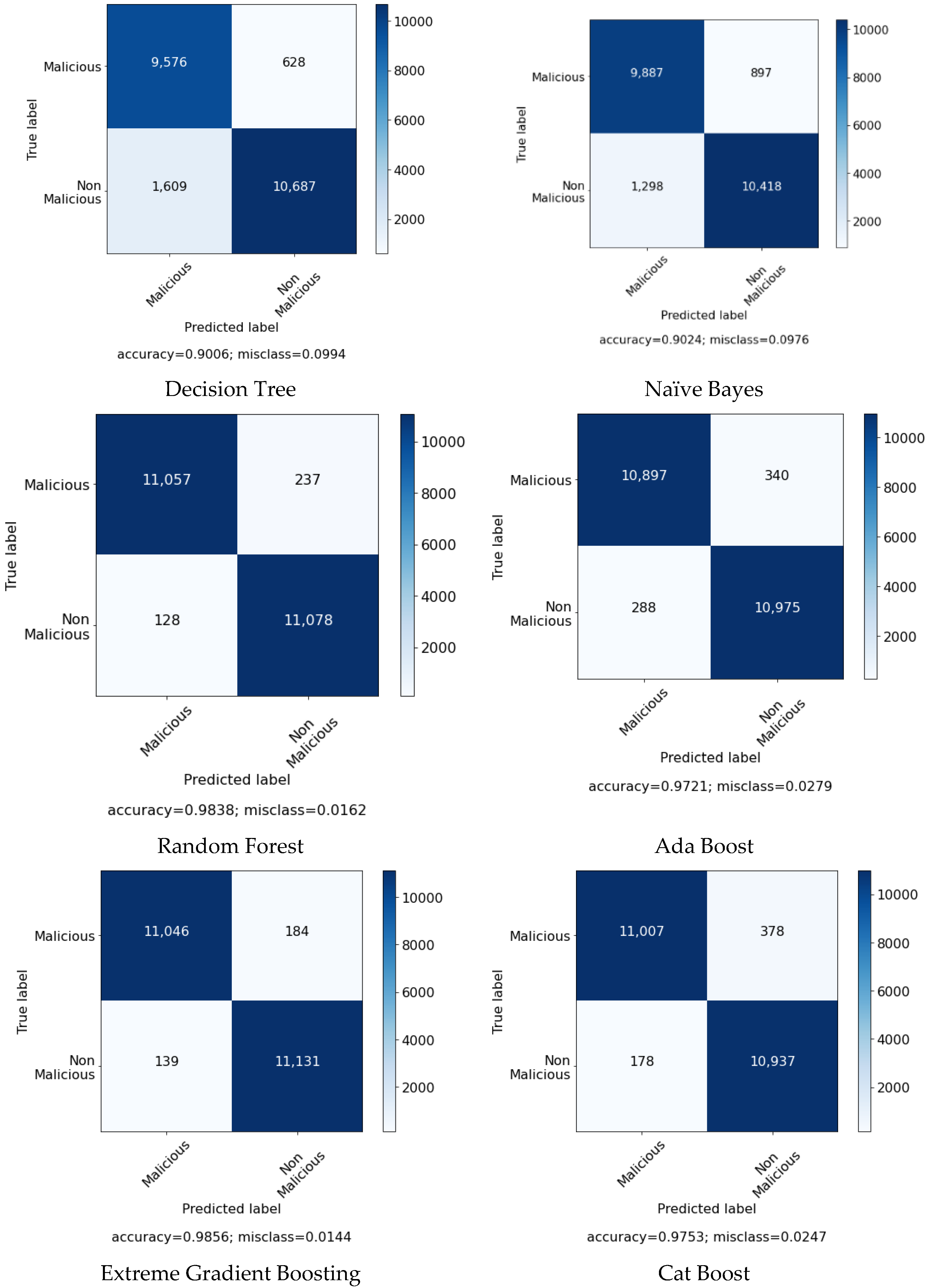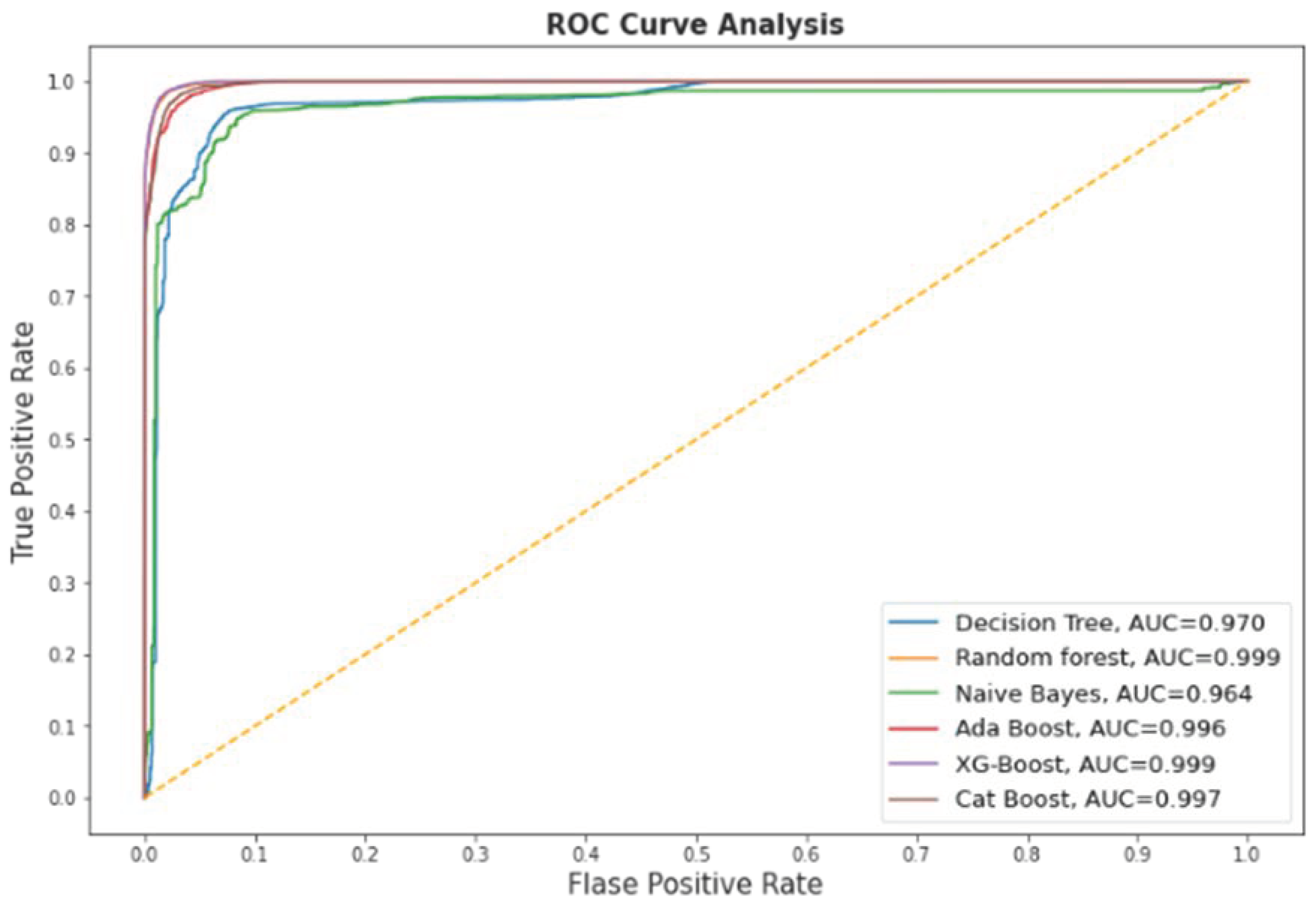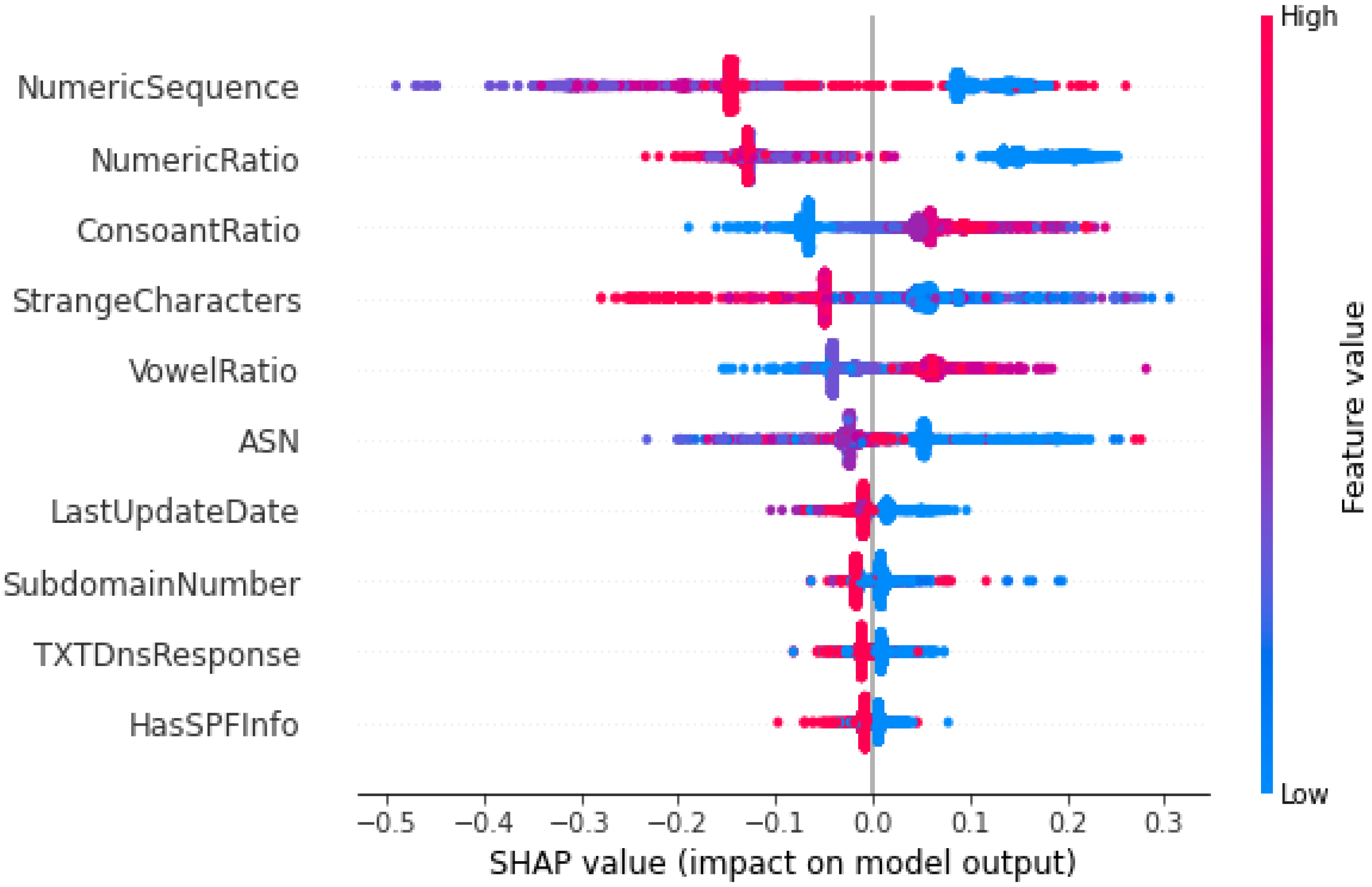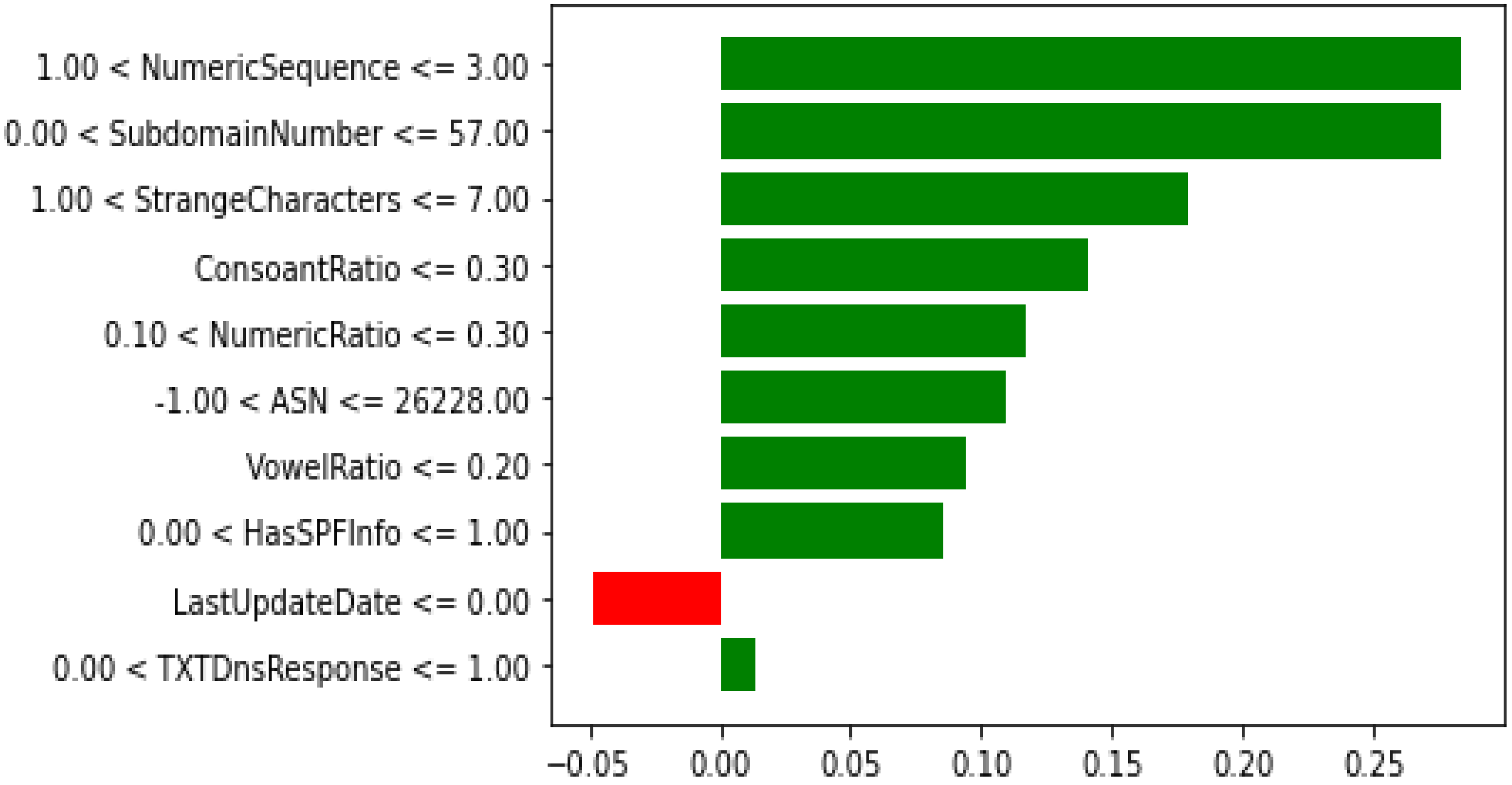1. Introduction
Nowadays, the expansion of the internet has raised the complexity of the network globally, creating more gaps that attract hackers to perform illegal activities aiming to target governments, violate companies’ privacy, or even manipulate individuals using phishing websites [
1]. One of the major threats that has grabbed researchers’ attention is the detection of malicious domains. Moreover, it is no longer possible to ignore the relationship between cyberattacks, information security, and their economic damage to organizations. In a recent report 2021, the International Data Corporation (IDC) showed that 87% of the organizations suffered from DNS attacks [
2].
The Domain Name System (DNS) has played a key role in the internet revolution. The primary goal was to ease the users’ experience by translating the IP address of a website into a memorable name and vice versa. When a user searches on a particular website, the DNS will reach the nearest root name server seeking to answer the requested query. Then, the root server will reach other top-level domain (TLD) servers—such as .com, .org, and .edu, collecting parts of the domine name until it finally finds the IP address of the website from the authoritative DNS server. Although it may seem that there is no control over the DNS, local DNS servers enable the internet service provider (ISP) to monitor the network traffic. Furthermore, DNS raises two main security concerns: it does not provide any authentication mechanism between the nodes nor encryption mechanism over the packet [
3]. The vulnerability from the structural perspective, DNS traffic tends to move towards a centric manner despite that the DNS is a decentralized system, leading the attackers to attack multiple entities at once easily. Additionally, the availability of DNS server information can threaten multiple companies, especially those who have poor DNS configuration. Such exposure could affect the DNS server operations and jeopardize the companies’ internal systems and data [
4]. Initially, methods such as capturing network traffic, web content, and URL inspection were used to detect malicious domains; however, the demand for Artificial Intelligence (AI) solutions is needed to automate the process of the detection. Initially, for the automated reasoning and decision making, either the rule-based or case-based approach was used. Later, the Machine Learning (ML) approach was introduced, and in the supervised ML, the main focus has been on the input and output data rather than how the output was made using the input data.
Firstly, basic ML models were introduced, such as Decision Tree (DT), Naïve Bayes (NB), linear regression, etc. These models contain good interpretability; however, they could not perform well for the highly complex problems. The emergence of the advance ML models that contain the complex structure and advance statistical methods such as ANN and SVM, as well as ensemble methods like GB, RF, etc., has dramatically improved the prediction and decision making. However, these models have introduced opaqueness in the reasoning. This opaqueness sometimes can restrict the use of these models in real-life applications. ML and DL models have contributed substantially for network and cyber security problems, such as the intrusion detection system (IDS), DNS classification, etc. [
1]. Despite the successful classification using ML and DL, most of the models failed to respond to the subject, which is deducing why a certain DNS has been classified as malicious. Considering this, these systems are less reliable and trustworthy.
Therefore, the current research trend has moved towards the development of the models that, along with the good prediction performance, also demonstrate interpretability and comprehensibility. The emergence of Explainable Artificial Intelligence (XAI) allows for the conversion of the black-box models into glass-box models by generating explanations [
5]. XAI-based models perform similar to the experts, and the models are more reliable and trustworthy [
6,
7]. XAI systems’ objectives are not merely to enhance a task with respect to the competence and accuracy, but also to offer explanations about how the particular decision was made. XAI provides an insight into the complex logic innate in the model [
8].
XAI has been applied in the cybersecurity system specifically in the detection of IDS. Recently, Mahbooba et al. [
9] performed a study to propose an explainable IDS model to enhance trust in the model. The aim of the study was to develop a model similar to the human way of reasoning to identify the effect of the malicious data for IDS. The stakeholders have the right to know why the particular activity has been identified as malicious. Correspondingly, Le et al. [
10] used the XAI for the IDS not only to generate an explanation, but also to help the cyber security professionals explore the validity and acceptability of the decisions. These explanations will help them to evaluate their judgement and decision. The study used the ensemble tree and shapley for the detection of IDS. Furthermore, Guo [
11] discussed that the emergence of 6G has greatly enhanced the use of Internet of Things (IOT), but, on the other hand, has posed a challenge for the security system. Various applications like the clinical decision system, remote surgery, and autonomous vehicle driving system require a transparent and trustworthy system [
12,
13]. Guo found that XAI enhanced the trust between AI and humans by integrating interpretability, transparency, and explicability.
Thus, it is essential to build interpretable ML models that will stimulate confidence in the knowledge they engender and provide to decision-makers. Therefore, in the current research, a post hoc XAI approach is used for the DNS classification.
In this paper, we propose a comprehensive comparison among Machine Learning (ML) models, including Decision Tree (DT), Naïve Bayes (NB), Random Forest (RF), Extreme Gradient Boosting (XGB), AdaBoost (AB), and Cat Boost (CB) algorithms, in order to classify the malicious and non-malicious domains using publicly available DNS datasets. Furthermore, XAI was used to generate the explanation at global and local level.
Our paper is structured as follows:
Section 2 covers the previous related work,
Section 3 covers the material and methods,
Section 4 discusses the experiments and results. Furthermore,
Section 5 contains the XAI, followed by further discussion in
Section 6, and finally,
Section 7 concludes the paper.
Contribution
The contribution of the proposed study is multi-fold. We aimed to develop a model with the enhanced performance in terms of accuracy, precision, recall, etc. without compromising the interpretability of the model. The main contributions of the proposed study are as follows:
Comparative analysis of interpretable and non-interpretable ML models for the classification of DNS.
Develop an interpretable model by using the post hoc XAI techniques to enhance the trust.
The current study achieved better results with reduced number of features when compared with the benchmark in terms of all evaluation measures. The model can be used as an effective tool for the identification of the malicious DNS.
2. Related Studies
ML and DL have been investigated for detecting the malicious domains for establishing the protected cyber environment. Some of the recent studies are discussed below. Initially, the studies that used the ML are discussed, followed by the DL models and the studies using both ML and DL models.
Kidmose et al. [
14] performed a study for classifying the malicious domain. They classified the domain features into three groups, one being generic and the remaining two being lexical features, specifically simple lexical features and advanced lexical features. Across many instances, the study found that utilizing lexical features with the other features can increase the detection efficiency of fraudulent websites using Random Forest (RF) with the precision of 0.98. Furthermore, Zhu and Zou et al. [
15] discovered that, as the detection procedure progresses, the detection performance of a standard Support Vector Machine (SVM) model decreases; however, a revised SVM technique (F-SVM) proposed by the study is effective in maintaining a significant precision rate throughout the detection phase. Due to its high performance, it is well-suited for online detection. F-SVM uses the concept of reinforcement learning to tackle the issues of expensive model upgrading costs. They achieved 0.983 precision rate in the real-time detection of malicious domains. Besides, Almashhadani et al. [
16] built a system called MaldomDetector that utilized easy to compute features in order to classify malicious domain names. The study combined several datasets from previous studies and used a randomness measuring algorithm to build the MaldomDetector. The results showed that the built model obtained high detection accuracy when compared with simple ML classifiers.
Moreover, Marques et al. [
17] suggested a DNS firewall based on ML to enhance spontaneous detection of fraudulent domain requests, using a dataset containing 34 attributes and 90,000 records derived from actual DNS traffic. The results demonstrate that ML techniques successfully categorized malicious and benign domains, with the CART algorithm having the best accuracy of 0.96 while using the Recursive Feature Elimination method.
Similarly, Palaniappan et al. [
18] investigated an ongoing DNS approach by identifying it as safe or dangerous via the extraction of attributes as DNS, web, blacklisting, and lexical sources. A compact dataset of roughly 10,000 domain names was employed to train and test a Logistic Regression (LR) algorithm, which attained an accuracy of almost 0.60. Identically, Magalhaes et al. [
19] provide a study on the effectiveness of using machine learning to detect fraudulent domain names taken from Alexa’s top 1 million sites. The Decision Tree (DT) has the highest classifier performance with 0.92 accuracy in 11 s, while the Naive Bayes (NB) achieves the shortest period with 2.77 s, but the accuracy drops to 0.76.
Some studies used the CIRA-CIC-DoHBrw-2020 dataset [
20,
21] in order to identify malicious DNS over HTTP. These studies focused on implementing and comparing different ML and DL models to assess the dataset. For instance, Singh and Roy [
22] used the DoH dataset to build and compare the performance of different Machine Learning (ML) classifiers, namely K-Nearest Neighbor (KNN), Naive Bayes (NB), Random Forest (RF), Logistic Regression (LR), and Gradient Boosting (GB). In the preprocessing phase, the authors removed the null attributes, selected the most efficient features, and performed a train-test split of 75–25 on the dataset. The results showed that GB and RF gave the best performance with precision, recall, and F-score values of 1.0 each. Additionally, Singh and Roy [
23] applied further analysis on their previous work [
22] by comparing RF with an ensemble learning framework of three classifiers: DT, LR, and KNN. Additionally, the DoHMeter was used as a tool for feature selection. The results showed that RF achieved a 1.0 accuracy on detecting both benign and malicious classes in contrast with the ensemble framework. In another study, Behnke et al. [
24] used two feature selection methods, Chi-squared and Pearson’s correlation, in order to choose the top 20 features from the dataset. After feature selection, 10-fold cross-validation was applied, and 10 ML classifiers were employed: RF, Decision Tree (DT), LightGBM, XGB, Extra Trees (ET), GB, Linear Discriminant Analysis (LDA), KNN, and AdaBoost (AB). The highest accuracy of 0.9978 was achieved by RF.
On the other hand, some studies used a DL approach in order to detect malicious domains. Hence, Akarsh et al. [
25] focused on real-time malicious domains obtained by (DGA) using the LSTM architecture. The study performed both binary and multi-class classification using two locally generated datasets. The binary classification gave the best accuracy of 0.9871 and multi-class gave an accuracy of 0.683. In another study, Chen et al. [
26] proposed an LSTM model that incorporates the attention mechanism, where the focus is more on important substrings in domains in order to improve the expression of domains. Using a real-life dataset, the study successfully achieved a reduced false alarm rate of 1.29% and false negative rate of 0.76%.
Likewise, Bharathi and Bhuvana [
27] applied DL methods to recognize fraudulent domain names by extracting textual characteristics from domain names and passing them to LSTM and bidirectional LSTM. The results obtained performed best for binary classification than multiclass classification when tested on a publicly shared dataset. The recall for LSTM and bidirectional LSTM is 0.956 and 0.97, respectively. In addition, Ma et al. [
28] presented a hybrid malicious domain detecting model based on Doc2vec, LSTM, and RNN for intense feature extraction and enhanced resilience. The composite result is linearly analyzed, and the probability distribution is determined by applying the Softmax classifier. When the hybrid model was compared to traditional domain identification algorithms, it came out on top with a 0.9781 accuracy. Amaizu et al. [
24] aimed at a hybrid network model that uses a CNN and an LSTM to classify net traffic as benign, malicious, or non-DoH. The model was trained for a total of 28 epochs and observed the outcomes. According to simulation findings, the proposed technique has a 0.99 accuracy in distinguishing between benign, malicious, and non-DoH classes.
Additionally, Vinayakumar et al. [
29] obtained the data for the study from local DNS records, and investigated the performance of several DL algorithms such Recurrent Neural Network (RNN), Long Short-Term Memory (LSTM), and other classic ML models. Among DL approaches, LSTM has performed the best in identifying malicious DNS requests. However, Xu et al. [
30] merged n-gram with CNN, and they suggested a new n-gram integrated character-based domain classification (n-CBDC) model. It simply needs the domain name alone and can autonomously evaluate the chance that the domain name was produced by domain generation algorithms (DGAs) without the assistance of manually obtained features or DNS context data. This model worked well in finding domain generation algorithm (DGA) domain addresses that were both comprehensible and centered on a wordlist. Conversely, Shi et al. [
31] used Extreme Learning Machine (ELM) to detect malicious domain names using their own generated dataset containing around 50,000 samples of malware and benign domains combined. The ELM model obtained a high detection accuracy of 0.96.
Despite the fact that there have been various research studies on detecting malicious domains, evaluating and identifying emerging fraudulent domains in a reasonable timeframe is an important security contingency plan. However, there is a need for further improvement and investigation. Most of the previous studies have proposed models that have produced significant outcomes but suffer from the black-box problem. Those models do not allow researchers to find the reason why the prediction was made. For critical problems where the misclassification cost is high, there is a need for finding why the particular prediction was made. Therefore, there is a need to investigate the techniques that achieve significant outcomes in terms of accuracy, precision, recall, etc., as well as to have better interpretability. Post hoc XAI has integrated the interpretability in the complex models without compromising the performance of the models [
32]. The post hoc explainable AI approach is applied after training the model; therefore, it will not affect the performance of the model. The XAI enables to incorporate the interpretability in the opaque models like SVM, ANN, ensemble-based models, and DL [
33]. Therefore, in the current study we used post hoc XAI along with the ML models to produce models with a significant outcome and better interpretability.
3. Materials and Methods
This research aims to examine and classify domains as malicious or non-malicious using a recent DNS dataset.
Figure 1 contains the conceptual framework of the proposed interpretable ML models for malicious domain detection. Initially ML models are implemented, then XAI techniques are employed to develop the interpretable models. Individually all the models are trained and tested using preprocessed features and selected features using sequential forward feature selector. The best performing model will be used to generate the explanations using XAI.
3.1. Dataset Description
The dataset used in this study was released by Marques et al. [
34] in 2021 to classify the data sample as malicious or non-malicious. It was created from DNS logs, where the non-malicious domain were acquired from Rapid7 Labs [
35] and the malicious domains from SANS Internet Storm Center (SANS) public list [
36]. The dataset is available on Mendeley data repository [
37]. Since it contains equal number of malicious and non-malicious domains, 45,000 samples for each, it does not suffer from any class imbalance. Further, it consists of 32 features of different datatype, i.e., text, Boolean, multi-class categorical, and numeric.
Table 1 contains the description of the dataset. The exploratory analysis of the dataset attributes is represented in terms of mode percentage for the binary and three class attributes, and for the numeric attribute, the mean (µ) and standard deviation (σ) are used. However, for the multi-class attributes, only the number of categories is mentioned.
It can be seen from the table that some of the boolean features like ‘HasDkimInfo’, ‘HasDmarcInfo’, ‘IpReputation’, ‘DomainReputation’, ‘DomainInAlexaDB’, and ‘CommonPorts’ have a less discriminative value. Most of the records have false values except for the ‘DomainInAlexaDB’ attribute. Therefore, these attributes were not selected during the feature selection mechanism. The entropy is calculated using Shannon entropy method. In the DNS record type MX indicate the mail exchange, CName indicate the registered name of the DNS, while A indicate the translator to convert DNS to IPv4 address. In the dataset the minimum DNS length is 4 and maximum is 153.
3.2. Preprocessing and Feature Selection
The dataset initially contains a total of 32 features describing relevant information about the malicious domains. ‘DomainName’, ‘DNSRecordType’, ‘CountryCode’, ‘RegisteredCountry’, and ‘RegisteredOrg’ attributes were removed. ‘DomainName’ and ‘DNSRecordType’ were removed from the dataset because they serve as identifiers in the dataset. Furthermore, ‘CountryCode’, ‘RegisteredCountry’, and ‘RegisteredOrg’ contain a huge number of null values; therefore, they were removed. However, binary encoding was performed on the Boolean features like “MXDnsResponse’, ‘TXTDnsResponse’, ‘HasSPFInfo’, ‘HasDkimInfo’, ‘HasDmarcInfo’, ‘DomainInAlexaDB’, ‘CommonPorts’, ‘IpReputation’, and ‘DomainReputation’. Furthermore, the multinomial attribute like ‘TLD’ was converted into sequential numbers. After the initial preprocessing, 27 features were selected. Feature selection was applied using the Sequential Forward Feature Selector (SFFS). This technique sequentially adds features to an empty set of features and assesses on until the inclusion of more features does not diminish the criterion and the algorithm can achieve the best performance and outcome. The algorithm for the SFFS is represented below (Algorithm 1).
| Algorithm 1:
Sequential Forward Feature Selection Algorithm
|
Create null set: Select optimum remaining features in a set:
If - a.
Update - b.
- c.
Continue with Step-2
|
Figure 2 below shows the ranking of the selected features based on information gain. The number of features after the feature selection was 10. The significance of the selected features is shown in the
Figure 2. Mostly, the feature selected in the current study was similar to the baseline study [
17] except for the numeric ratio and vowel ratio. While the creation date was selected in the baseline, the forward sequential feature selector was not selected for this feature. They used AutoML to select the features and develop the models. In the current study, 10 features were selected, while in the baseline study, 9 features were used.
3.3. Machine Learning Models
The following models were used in the current study for the detection of malicious DNS. In ML, some of the classifiers contain huge number of parameters and the value of these parameters have a high impact on the learning performance of the classifier and are known as hyperparameters. The value of these hyperparameters needs to be tuned to find the most optimal value, with the aim to minimize the loss function. In the current study, grid search uses the exhaustive searching mechanism for the optimal parameter values. In each iteration, the algorithm finds the parameter values and then evaluates the performance of the algorithm, and the values with the best outcome will be the final values of the classifier’s parameter [
38]. Gird search cross-validation is applied in the current to find the optimal values for the set of classifiers using GridSearchCV method in the sk-learn python library.
Decision Tree: A decision tree (DT) is a structure that resembles a flowchart, with every inner node indicating an attribute test, each branch representing the test’s result, and each leaf node (terminal node) storing a class label. By starting with the root node, the technique for establishing classes for a provided dataset in a DT begins. This method compares the root attribute values with the recorded (actual dataset) attribute values and thus pursues the branch and leaps to the following node depending on the difference.
Naïve Bayes: Naive Bayes (NB) is a statistical classification algorithm that follows the Bayes theorem, and each feature is unrelatable to the other features. Moreover, the Bayes theorem states that the probability of target class A given predictor B is equal to the likelihood of the predictor B given target class A multiplied by the probability of target class A and divided by the probability of predictor B.
Random Forest: Random Forest (RF) is a classification algorithm that calculates the mean of outcomes of a collection of DTs with various subgroups of a dataset to enhance the dataset’s projected accuracy. Instead of depending on an individual DT, the RF gathers predictions from all trees and expects the ultimate result depending on the majority of votes. Performance increases with more trees in the forest and the risk of overfitting is reduced.
Table 2 shows the parameters used for the RF classifier.
Extreme Gradient Boosting: Gradient boosting (GB) is an ensemble method for developing predictive models. Generally, the approach is employed in regression and classification operations. Gradient boosting, like other boosting approaches, allows for the generalization and optimization of differentiable loss functions. The Extreme Gradient Boosting (XGB) technique extends the extent of gradient boosting. It mainly aimed at increasing the performance and speed of a ML model. By parallelizing DT computations, it enhances the model’s performance.
Table 3 contains the parameter values of the XGB using in the study.
AdaBoost: Adaboost (AB) is also an ensemble-based model that utilizes predictions from tiny one-level DTs to create a single prediction. AdaBoost algorithms are used because they attempt to utilize many weak models and then adjust predictions by adding further weak models. The training approach starts with a single decision tree, which is used to detect and weight misclassified samples in the training dataset.
Table 4 contains the parameter values for AB.
CatBoost: CatBoost stands for categorical boosting. It is also based on the DT and gradient boosting but with reduced parameters. Therefore, CatBoost takes less training and testing time as compared with the other ensemble models. This model usually gives good performance with the default parameters. CatBoost can be applied on the numeric data after performing the data encoding. In the proposed study, most of the features were categorical; furthermore, for the non-categorical attributes, data encoding was performed; therefore, Catboost was used.
Table 5 contains the parameters values for the Catboost used in the current study.
3.4. Evaluation Metrics
The proposed model’s performance was compared in terms of accuracy, precision, recall, F1, Area Under the Curve (AUC), and score time. Furthermore, the outcome of the classifiers was also represented using a confusion matrix. The matrix contains four variables, i.e., malicious DNS that is classified as malicious is represented as True Positive (TP), and malicious DNS that is classified as non-malicious is represented as False Positive (FP). Furthermore, non-malicious DNS that is classified as non-malicious is represented by True Negative (TN), and non-malicious DNS that is classified as malicious is represented by False Negative (FN).
Accuracy (Acc) represents the ratio of correctly classified DNS to the total number of DNS in the test set.
Recall (R), also known as sensitivity, represents the ability of the model to correctly classify the malicious DNS.
Precision (P) represents ratio of correctly predicted malicious DNS to the sum of correctly and incorrectly predicted malicious DNS.
F1-score represents the harmonic mean of precision and recall.
Area Under the Curve (AUC) is used to test and compare binary classification model performance. It quantifies your predictive classification model’s discriminating ability.
Furthermore, for the detection of malicious DNS, time is one of the significant factors. Therefore, score time is also calculated, which corresponds to the time taken for the model to make the prediction. Score time is represented in seconds.
4. Experiments and Results
To perform the experiments, six ML models were used. The ML classifiers included both simple classifiers, such as DT and NB, and ensemble classifiers, such as RF, XGB, RF, AB, and Catboost. Python (ver. Python 3.10.1) was used to build the proposed models using google collab. The libraries used in the study were pandas, numpy, matplot, sklearn, and Dalex. The dataset used in the study initially contained 32 features and a target class that classifies the samples into malicious and non-malicious domains. Two sets of experiments were performed, i.e., the dataset before feature selection (number of features 27) and after the feature selection (number of features 10). Feature selection was performed using the forward sequential feature selector. The holdout method was used to divide the dataset into training and testing with the ratio of 75:25.
Figure 3 contains the flow of the experimental setup adopted in the current study.
Table 6 contains the testing result of the classification models before feature selection. However,
Table 6 represents the testing results of the classification model after the feature selection.
Table 6 and
Table 7 list the performance measures of the applied classifiers before and after feature selection, respectively. XGB outperformed the other classifier with the full features in terms of accuracy, AUC, precision, and F1-score. However, RF achieved the highest recall, which is similar to the recall achieved by XGB. While the DT attained the least score time of 0.0077 s. Furthermore, the accuracy of RF and XGB is also related in both the experiments. Similarly, in the second experiment, with the selected features, XGB attained the best outcome as compared to the other classifier with all the measures except the recall and time elapsed. The performance of the XGB with selected features was reduced by 0.0038, which is a very small difference; however, the number of features was reduced from 27 to 10. However, the score time was reduced to more than half. Like the first experiment, in the second experiment, DT achieved the least score time of 0.0078 s; nevertheless, it achieved a lower outcome in other measures. However, NB achieved the lowest accuracy of 0.8479 after the feature selection. While RF took the huge score time of 0.4500 s. Among the ensemble models, CatBoost achieved the lowest score time, since one of the key benefits of Catboost is that it is faster compared to the other ensemble models.
Keeping in view the performance of the models and time elapsed, XGB with the reduced features are selected as a final model for the detection of the malicious DNS. XAI was applied on the XGB trained model with the reduced feature set.
Figure 4 contains the confusion matrix of the models without the feature selection algorithm.
Figure 5 contains the confusion matrix of the models with the selected features. Furthermore,
Figure 6 contains the ROC curve of the models after the feature selection.
6. Further Discussion
The proposed study aims to develop a model for the detection of malicious DNS with the better performance, speed, and interpretability, which could protect the system and data from the malicious attack. The models used were classical ML models like DT and NB; furthermore, ensemble models like RF, AB, XGB, and CB were used with the balanced malicious DNS dataset published by Magalhaes et al. [
19]. Feature selection was performed using the sequential feature selector. Furthermore, XAI was used to incorporate the interpretability in the ensemble-based black-box ML models. The current dataset was also used in the study by Marques et al. [
17]. The authors initially published the dataset and then used the ML models for the malicious DNS. They used several classical ML models like SVM, LR, LDA, KNN, DT (CART), and NB. Furthermore, three feature selection algorithms were compared like univariate filter, Recursive Feature Elimination (RFE), and feature importance. They found that CART achieved the highest results compared with the other models.
Table 8 contains the comparison of the proposed model with the benchmark. As seen from the table, the proposed study achieved better results compared with the benchmark. However, the score time of benchmark was 0.025 s, which is lower compared with the current study, i.e., 0.0424 s. Nevertheless, score time is one of the significant measures, but considering the outcome achieved in terms of recall, accuracy, precision, and F1-score, the difference of the score time is acceptable.
To summarize, the proposed study achieved significant outcomes. Furthermore, the XAI considered in the study enhanced the interpretability along with the performance of the model. XAI has recently gained a lot of attention in several domains like healthcare, education, business, engineering, cyber security, and network monitoring. Indeed, the model achieved promising results but also suffers from the limitation that the study only investigate a single dataset. Furthermore, the time to detect the malicious DNS needs to be further reduced by investigating some light models like LGBM.
7. Conclusions
The significant effects of malicious domains motivated many researchers to find more effective methods to classify malicious and non-malicious domains. Additionally, the traditional approaches would not be beneficial in the near future due to the dependency on human expertise that may not cooperate with the rapid development of the internet. In this paper, we examined multiple ML models. such as DT, NB, RF, AB, XGB, and CB, to detect malicious domains using the datasets containing 45,000 samples of each of the malicious and non-malicious domains. Feature selection was performed using the forward feature selector. Two experiments were conducted, i.e., using the preprocessed data (27 features) and the reduced features data (10 features) after the feature selection. XGB outperformed all the classifiers using 27 features with an AUC of 0.9991, accuracy of 0.9856, precision of 0.9836, F1 score of 0.9856, while the RF achieved the highest recall of 0.9886 without feature selection. The score time is one of the most important factors, and the results achieved by XGB with and without feature selection were similar, while the score time was much less; therefore, we considered XGB with the feature selection as the final model for the XAI. The XGB algorithm using feature selection techniques produced values of 0.999, 0.9818, 0.9779, and 0.9818 in AUC, accuracy, precision, and F1-score, respectively, with the score time of 0.0424. XAI was used for the global and local interpretation using the Global Surrogate Model, Shapley, and LIME. The study outperformed the benchmark study except for the score time and has thus shown promising results. However, there is still room for improvement by investigating the performance of the proposed model with larger and more datasets.
